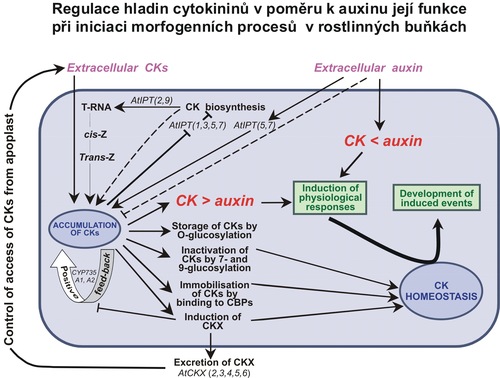Metabolism and physiological function of cytokinins
Cytokinins are naturally occurring phytohormones that regulate cell division and differentiation and thus efficiently control plant growth and development. Endogenous levels of bioactive cytokinins and their mode of action in plants are regulated at different levels and by various mechanisms concerning biosynthesis, metabolic conversions, inactivation and degradation as well as signalling pathways and transport.
In our laboratory, we have proposed a model for the metabolic regulation of cytokinin contents and interrelation between cytokinins and auxins based on auto-induction of cytokinin accummulation in competent cells, stimulation of cytokinin degradation by substrates and cytokinin inactivation by glycosylation (Kamínek et al., Physiol Plant 1997).

Model of metabolic regulation of cytokinins.
This model elucidates mechanisms of establishment of transient hormonal imbalance leading to induction of specific morphogenic processes and differentiation of various organs and subsequent re-establishment and maintenance of hormonal homeostasis required for further development and termination of induced physiological events. We have verified the validity of this model in in vitro cultures of plant cells and tissues as well as in intact plants, in which the content of native cytokinins was experimentally modified either by exogenously applied natural or synthetic cytokinins (Auer et al., Physiol Plant 1999; Motyka et al., Physiol Plant 2003) or by expression of genes encoding enzymes participating in regulation of levels of precursors (farnesyl diphosphate synthase; Manzano et al., Plant Mol Biol 2006), biosynthesis (isopentenyl transferase; Galichet and Hoyerová et al., Plant Physiol 2008; Sýkorová et al., J Exp Bot 2008; Yevdakova et al., J Plant Growth Regul 2008), degradation (cytokinin oxidase/dehydrogenase; Werner et al., PNAS 2001 ; Werner et al., Plant Cell 2003; von Schwartzenberg et al., Plant Physiol 2007) of cytokinins and cytokinin signal transduction (Frank et al., Plant Physiol 2000). Using mutants of model plants (Arabidopsis, moss Physcomitrella, wheat) we have also confirmed that phenotypic changes reflect proportions between cytokinin and auxin levels as well as changes in corresponding gene expression and enzyme activities.
Metodically, we have developed a novel extraction and purification procedure for phytohormones allowing separation of auxin and abscisic acid from cytokinins (Dobrev a Kamínek, J Chromatogr A 2002) and their reliable identification and quantification by 2D-HPLC or mass spectrometry (Dobrev et al., J Chromatogr A 2005). We have evaluated efficiency of different methods of cytokinin extraction and purification and optimized the procedure reducing contents of interfering substances and thus enhancing responses of labelled internal standards (Hoyerová et al., Phytochemistry 2006). We have also developed a method for simultaneous analysis of cytokinin oxidase/dehydrogenase and zeatin reductase enzyme activities in plants. On this basis we have found competitive effects of both enzymes in regulation of cytokinin concentrations and have determined their roles for maintenance of hormonal homeostasis (Gaudinová et al., J Plant Growth Regul 2005).
Using various model plants we have demonstrated a physiological significance of cytokinins in control of plant morphogenesis (Auer et al., Physiol Plant 1999; Sriskandarajah et al., J Plant Growth Regul 2006), senescence (Ananieva et al., Physiol Plant 2004a; 2004b and 2008; Conrad et al., Physiol Plant 2007) and in regulation of uptake and utilization of mineral nitrogen (Sýkorová et al., J Exp Bot 2008).
In addition to the above mentioned activities, we focus presently on the study of different aspects of metabolism and physiological functions of cis-zeatin-type cytokinins and elucidation of potential control of cytokinin contents and activities in plants during the root-to-shoot transport. We also pay attention to possible utilization of our findings to affect and improve productivity of crop plants.